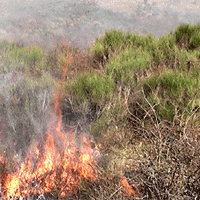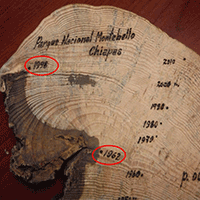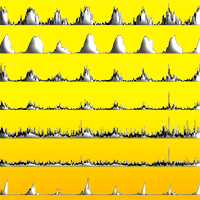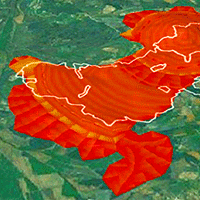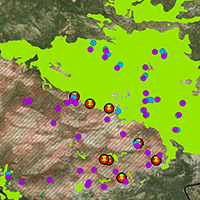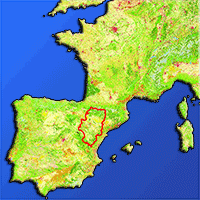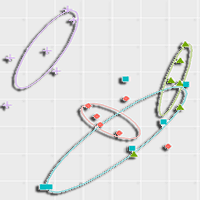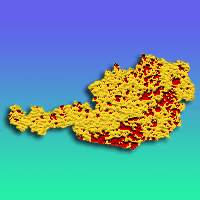Climate and weather play an important role in shaping fire activity patterns by controlling fuel productivity and fire spread, respectively. Additionally, climate is a key factor controlling primary productivity while different climate zones are expected to support different vegetation formations, that on their turn, include different fuel types. The use, therefore, of an underlying phytogeographical framework would provide more comprehensive outputs in exploring fire activity patterns at national scales, instead of using administrative units that could include various types of non-ecological divisions. Within this concept, we examined the recent fire activity of the main forest formations occurring in Greece and we explored their relationships with various weather parameters and indexes. Correlations of number of fires with weather variables, especially among the vegetation formations that summarize most of the human influence were lax, yet burned area showed significant correlations mainly with fire season precipitation totals. The precipitation related variables generally outperformed the temperature-related variables in correlating with both number of fires and burned area. Climatic indexes, which embody the combined effects of precipitation and air temperature, reflected improved correlations, but not to the extent that could allow for the promotion of their use in further modeling.
Keywords
, , ,
Citation
Xystrakis F, Koutsias N (2013). Differences of fire activity and their underlying factors among vegetation formations in Greece. iForest 6: 132-140. - doi: 10.3832/ifor0837-006
Academic Editor
Marco Borghetti
Paper history
Received: Oct 25, 2012
Accepted: Nov 23, 2012
First online: Apr 08, 2013
Publication Date: Jun 01, 2013
Publication Time: 4.53 months
© SISEF - The Italian Society of Silviculture and Forest Ecology 2013
Open Access
This article is distributed under the terms of the Creative Commons Attribution-Non Commercial 4.0 International (https://creativecommons.org/licenses/by-nc/4.0/), which permits unrestricted use, distribution, and reproduction in any medium, provided you give appropriate credit to the original author(s) and the source, provide a link to the Creative Commons license, and indicate if changes were made.

Breakdown by View Type
(Waiting for server response...)
Article Usage
Total Article Views: 59686
(from publication date up to now)
Breakdown by View Type
HTML Page Views: 49145
Abstract Page Views: 4348
PDF Downloads: 4227
Citation/Reference Downloads: 65
XML Downloads: 1901
Web Metrics
Days since publication: 4617
Overall contacts: 59686
Avg. contacts per week: 90.49
Article Citations
Article citations are based on data periodically collected from the Clarivate Web of Science web site
(last update: Mar 2025)
Total number of cites (since 2013): 14
Average cites per year: 1.08
Publication Metrics
by Dimensions ©
Articles citing this article
List of the papers citing this article based on CrossRef Cited-by.
(1)
Arianoutsou M (1998)Aspects of demography in post-fire mediterranean plant communities of Greece. In: “Landscape Disturbance and Biodiversity in Mediterranean-Type Ecosystems” (Rundel PW, Montenegro G, Jaksic FM eds). Ecological studies, vol. 136, Springer, Berlin-Heidelberg, Germany.
Gscholar
(2)
Arianoutsou M (2001)Landscape changes in Mediterranean ecosystems of Greece: implications for fire and biodiversity issues. Journal of Mediterranean Ecology 2: 165-178.
Gscholar
(3)
Bessie WC, Johnson EA (1995)The relative importance of fuels and weather on fire behavior in sub-alpine forests. Ecology 76 (3): 747-762.
CrossRef |
Gscholar
(4)
Bohn U, Gollub G, Hettwer C, Zupancic M, Puncer I, Seliškar A (2000)Map of the natural vegetation of Europe: scale 1: 2.500.000. Bundesamt für Naturschutz, Münster-Hiltrup, Germany. [in German].
Gscholar
(5)
Bond WJ, Woodward FI, Midgley GF (2005)The global distribution of ecosystems in a world without fire. New Phytologist 165 (2): 525-537.
CrossRef |
Gscholar
(6)
Brockwell PJ, Davis RA (2002)Introduction to time series and forecasting (6
th edn). Springer Verlag, New York, USA.
Gscholar
(7)
Carvalho A, Flannigan MD, Logan K, Miranda AI, Borrego C (2008)Fire activity in Portugal and its relationship to weather and the Canadian Fire Weather Index System. International Journal of Wildland Fire 17 (3): 328-338.
CrossRef |
Gscholar
(8)
Cowling RM, Rundel PW, Lamont BB, Arroyo MK, Arianoutsou M (1996)Plant diversity in Mediterranean-climate regions. Trends in Ecology and Evolution 11 (9): 362-366.
CrossRef |
Gscholar
(9)
Cryer JD, Chan K-S (2008)Springer texts in statistics. Springer, New York, USA, pp. 249-276.
CrossRef |
Gscholar
(10)
Dimitrakopoulos A, Gogi C, Stamatelos G, Mitsopoulos I (2011a)Statistical analysis of the fire environment of large forest fires (> 1000 ha) in Greece. Polish Journal of Environmental Studies 20 (2): 327-332.
Gscholar
(11)
Dimitrakopoulos AP, Vlahou M, Anagnostopoulou CG, Mitsopoulos ID (2011b)Impact of drought on wildland fires in Greece: implications of climatic change? Climatic Change 109 (3-4): 331-347.
CrossRef |
Gscholar
(12)
Dwyer E, Grégoire J-M, Pereira J (2000)Climate and vegetation as driving factors in global fire activity. In: “Biomass Burning and its Inter-Relationships with the Climate System” (Innes JL, Beniston M, Verstraete MM eds). Advances in Global Change Research, vol. 3, Springer, The Netherlands, pp. 171-191.
CrossRef |
Gscholar
(13)
Flannigan M, Stocks B, Turetsky M, Wotton M (2009)Impacts of climate change on fire activity and fire management in the circumboreal forest. Global Change Biology 15 (3): 549-560.
CrossRef |
Gscholar
(14)
Gavilán R, Fernández-González F (1997)Climatic discrimination of Mediterranean broad-leaved sclerophyllous and deciduous forests in central Spain. Journal of Vegetation Science 8 (3): 377-386.
CrossRef |
Gscholar
(15)
Gedalof Z, Peterson DL, Mantua NJ (2005)Atmospheric, climatic, and ecological controls on extreme wildfire years in the northwestern United States. Ecological Applications 15 (1): 154-174.
CrossRef |
Gscholar
(16)
Good P, Moriondo M, Giannakopoulos C, Bindi M (2008)The meteorological conditions associated with extreme fire risk in Italy and Greece: relevance to climate model studies. International Journal of Wildland Fire 17 (2): 155-165.
CrossRef |
Gscholar
(17)
Gouvas M, Sakellariou N (2011)Climate and forest vegetation in Greece. National Observatory of Athens, Athens, Greece. [in Greek]
Gscholar
(18)
Hessl AE (2011)Pathways for climate change effects on fire: models, data, and uncertainties. Progress in Physical Geography 35 (3): 393-407.
CrossRef |
Gscholar
(19)
Hintze JL, Nelson RD (1998)Violin plots: a box plot-density trace synergism. American Statistician 52 (2): 181-184.
Gscholar
(20)
Hipel KW, McLeod AI (1994)Time series modelling of water resources and environmental systems. Elsevier, Amsterdam, The Netherlands.
Gscholar
(21)
Holden ZA, Morgan P, Crimmins MA, Steinhorst RK, Smith AMS (2007)Fire season precipitation variability influences fire extent and severity in a large southwestern wilderness area, United States. Geophysical Research Letters 34 (16): 1-5.
CrossRef |
Gscholar
(22)
Iliadis LS, Papastavrou AK, Lefakis PD (2002)A computer-system that classifies the prefectures of Greece in forest fire risk zones using fuzzy sets. Forest Policy and Economics 4 (1): 43-54.
CrossRef |
Gscholar
(23)
Kalabokidis KD, Koutsias N, Konstantinidis P, Vasilakos C (2007)Multivariate analysis of landscape wildfire dynamics in a Mediterranean ecosystem of Greece. Area 39 (3): 392-402.
CrossRef |
Gscholar
(24)
Kostinakis K, Xystrakis F, Theodoropoulos K, Stathis D, Eleftheriadou E, Matzarakis A (2011)Estimation of reference potential evapotranspiration with focus on vegetation science - the EmPEst software. Journal of Irrigation and Drainage Engineering 137 (9): 616-619.
CrossRef |
Gscholar
(25)
Koutsias N, Arianoutsou M, Kallimanis AS, Mallinis G, Halley JM, Dimopoulos P (2012)Where did the fires burn in Peloponnisos, Greece the summer of 2007? Evidence for a synergy of fuel and weather. Agricultural and Forest Meteorology 156 (1): 41-53.
CrossRef |
Gscholar
(26)
Koutsias N, Karteris M (2003)Classification analyses of vegetation for delineating forest fire fuel complexes in a Mediterranean test site using satellite remote sensing and GIS. International Journal of Remote Sensing 24 (15): 3093-3104.
CrossRef |
Gscholar
(27)
Koutsias N, Xanthopoulos G, Founda D, Xystrakis F, Nioti F, Pleniou M, Mallinis G (2013)On the relationships between forest fires and weather conditions in Greece from long-term national observations (1894-2010). International Journal of Wildland Fire. [in press]
CrossRef |
Gscholar
(28)
Krawchuk MA, Moritz MA (2011)Constraints on global fire activity vary across a resource gradient. Ecology 92: 121-132.
CrossRef |
Gscholar
(29)
Littell JS, Gwozdz RB (2011)Climatic water balance and regional fire years in the Pacific Northwest, USA: linking regional climate and fire at landscape scales. In: “The Landscape Ecology of Fire” (McKenzie D, Miller C, Falk DA eds). Ecological studies, vol. 123, Springer Science and Business Media BV, New York, USA.
CrossRef |
Gscholar
(30)
Littell JS, McKenzie D, Peterson DL, Westerling AL (2009)Climate and wildfire area burned in western US ecoprovinces, 1916-2003. Ecological Applications 19 (4): 1003-1021.
CrossRef |
Gscholar
(31)
Mavromatis G (1980)The bioclimate of Greece: relations between climate and natural vegetation, bioclimatic maps. Forest Research 1: 1-63. [in Greek]
Gscholar
(32)
Moreira F, Catry F, Rego F, Bacao F (2010)Size-dependent pattern of wildfire ignitions in Portugal: when do ignitions turn into big fires? Landscape Ecology 25 (9): 1405-1417.
CrossRef |
Gscholar
(33)
Moreira F, Viedma O, Arianoutsou M, Curt T, Koutsias N, Rigolot E, Barbati A, Corona P, Vaz P, Xanthopoulos G, Mouillot F, Bilgili E (2011)Landscape - wildfire interactions in southern Europe: Implications for landscape management. Journal of Environmental Management 92 (10): 2389-2402.
CrossRef |
Gscholar
(34)
Moreno JM, Vázquez A, Veléz R (1998)Recent history of forest fires in Spain. In: “Large Forest Fires” (Moreno JM ed). Backhuys Publishers, Leiden, The Netherlands, pp. 159-185.
Gscholar
(35)
Moreno JM, Viedma O, Zavala G, Luna B (2011)Landscape variables influencing forest fires in central Spain. International Journal of Wildland Fire 20 (5): 678-689.
CrossRef |
Gscholar
(36)
Moriondo M, Good P, Durao R, Bindi M, Giannakopoulos C, Corte-Real J (2006)Potential impact of climate change on fire risk in the Mediterranean area. Climate Research 31 (1): 85-95.
CrossRef |
Gscholar
(37)
Mouillot F, Ratte JP, Joffre R, Moreno JM, Rambal S (2003)Some determinants of the spatio-temporal fire cycle in a Mediterranean landscape (Corsica, France). Landscape Ecology 18 (7): 665-674.
CrossRef |
Gscholar
(38)
Pausas JC, Llovet J, Rodrigo A, Vallejo R (2008)Are wildfires a disaster in the Mediterranean basin? A review. International Journal of Wildland Fire 17 (6): 713-723.
CrossRef |
Gscholar
(39)
Pausas JG (2004)Changes in fire and climate in the eastern Iberian peninsula (Mediterranean basin). Climatic Change 63 (3): 337-350.
CrossRef |
Gscholar
(40)
Pausas JG, Fernandez-Munoz S (2012)Fire regime changes in the western Mediterranean basin: from fuel-limited to drought-driven fire regime. Climatic Change 110 (1-2): 215-226.
CrossRef |
Gscholar
(41)
Pausas JG, Paula S (2012)Fuel shapes the fire-climate relationship: evidence from Mediterranean ecosystems. Global Ecology and Biogeography 21 (11): 1074-1082.
CrossRef |
Gscholar
(42)
Piñol J, Terradas J, Lloret F (1998)Climate warming, wildfire hazard, and wildfire occurrence in coastal eastern Spain. Climatic Change 38 (3): 345-357.
CrossRef |
Gscholar
(43)
R Development Core Team (2011)R: a language and environment for statistical computing (2.14.0 edn). Vienna, Austria.
Gscholar
(44)
Rundel PW (1981)Fire as an ecological factor. In: “Physiological Plant Ecology. I. Responses to the Physical Environment” (Lange OL, Nobel PS, Osmond CB, Ziegler H eds). Springer-Verlag, Berlin, Germany, pp. 501-538.
Gscholar
(45)
Scozzafava S, De Sanctis A (2006)Exploring the effects of land abandonment on habitat structures and on habitat suitability for three passerine species in a highland area of Central Italy. Landscape and Urban Planning 75 (1-2): 23-33.
CrossRef |
Gscholar
(46)
Tanskanen X, Heidi X, Ven X, Inen X, Ari X (2008)The relationship between fire activity and fire weather indices at different stages of the growing season in Finland. Vol. 13, Finnish Environment Institute, Helsinki, Finland.
Gscholar
(47)
Tsagari K, Karetsos G, Proutsos N (2011)Forest fires in Greece, 1983-2008. WWF Hellas, NAGREF-IMFE & TFP, Athens, Greece.
Gscholar
(48)
Tuhkanen S (1980)Climatic parameters and indices in plant geography. Acta Phytogeogrica Suecica, vol. 67, Almqvist & Wiksell International, Sweden.
Gscholar
(49)
Turetsky MR, Amiro BD, Bosch E, Bhatti JS (2004)Historical burn area in western Canadian peatlands and its relationship to fire weather indices. Global Biogeochemical Cycles 18 (4): 1-9.
CrossRef |
Gscholar
(50)
Vasilakos C, Kalabokidis K, Hatzopoulos J, Matsinos I (2009)Identifying wildland fire ignition factors through sensitivity analysis of a neural network. Natural Hazards 50 (1): 125-143.
CrossRef |
Gscholar
(51)
Vázquez A, Moreno JM (1993)Sensitivity of fire occurrence to meteorological variables in mediterranean and atlantic areas of Spain. Landscape and Urban Planning 24 (1-4): 129-142.
CrossRef |
Gscholar
(52)
Vázquez A, Pérez B, Fernández-González F, Moreno JM (2002)Recent fire regime characteristics and potential natural vegetation relationships in Spain. Journal of Vegetation Science 13 (5): 663-676.
CrossRef |
Gscholar
(53)
Vega-García C, Chuvieco E (2006)Applying local measures of spatial heterogeneity to Landsat-TM images for predicting wildfire occurrence in Mediterranean landscapes. Landscape Ecology 21 (4): 595-605.
CrossRef |
Gscholar
(54)
Viedma O (2008)The influence of topography and fire in controlling landscape composition and structure in Sierra de Gredos (Central Spain). Landscape Ecology 23 (6): 657-672.
CrossRef |
Gscholar
(55)
Viedma O, Angeler DG, Moreno JM (2009)Landscape structural features control fire size in a Mediterranean forested area of central Spain. International Journal of Wildland Fire 18 (5): 575-583.
CrossRef |
Gscholar
(56)
Viegas DX, Viegas MT (1994)A relationship between rainfall and burned area for Portugal. International Journal of Wildland Fire 4 (1): 11-16.
CrossRef |
Gscholar
(57)
Walter H, Lieth H (1967)Klimadiagram-Weltatlas. VEB Gustav Fischer Verlag, Jena, Germany. [in German]
Gscholar
(58)
Westerling AL, Gershunov A, Brown TJ, Cayan DR, Dettinger MD (2003)Climate and wildfire in the western United States. Bulletin of the American Meteorological Society 84 (5): 595-604.
CrossRef |
Gscholar
(59)
Xu CY (1997)Application of water balance models to different climatic regions of China for water resources assessment. Water Resources Management 11: 51-67.
CrossRef |
Gscholar
(60)
Xystrakis F, Matzarakis A (2011)Evaluation of 13 empirical reference potential evapotranspiration equations on the island of Crete in southern Greece. Journal of Irrigation and Drainage Engineering 137 (4): 211-222.
CrossRef |
Gscholar
(61)
Zumbrunnen T, Menéndez P, Bugmann H, Conedera M, Gimmi U, Bürgi M (2012)Human impacts on fire occurrence: a case study of hundred years of forest fires in a dry alpine valley in Switzerland. Regional Environmental Change 12 (4): 935-949.
CrossRef |
Gscholar
(62)
Zumbrunnen T, Pezzatti GB, Menendez P, Bugmann H, Burgi M, Conedera M (2011)Weather and human impacts on forest fires: 100 years of fire history in two climatic regions of Switzerland. Forest Ecology and Management 261 (12): 2188-2199.
CrossRef |
Gscholar


